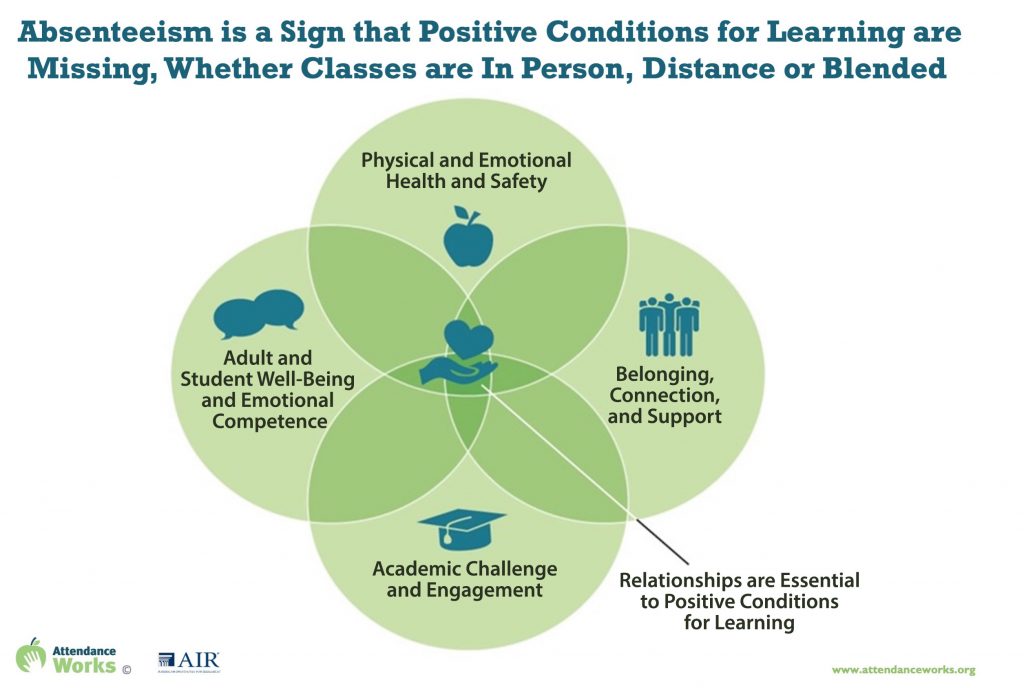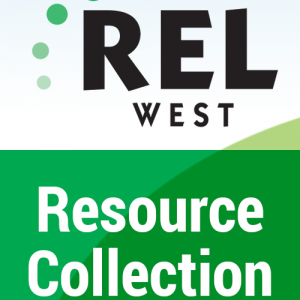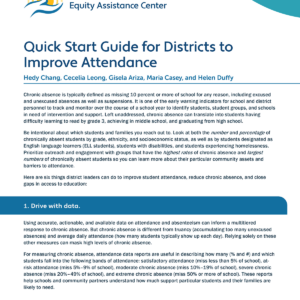6 Actions Districts Can Take to Improve Student Attendance and Engagement
Posted on

Every day during roll call, educators encounter one of the most pervasive challenges to student success–chronic absenteeism. Chronic absenteeism is defined as missing at least 10 percent of school for any reason, including excused and unexcused absences and suspensions. Nationally, chronic absence rates nearly doubled from pre-pandemic levels[i]. Chronic absences can lead to difficulty learning to read by the third grade, lagging achievement in middle school, and not graduating from high school.
To address this urgent issue and to identify actionable steps for local, tribal, state, and federal educators, the Western Educational Equity Assistance Center–or WEEAC– is continuing its webinar series on chronic absenteeism this fall. Designed by our partners at Attendance Works, this series provides equity-driven strategies for promoting student attendance and engagement.
Attendance Works has also created the Quick Start Guide for Districts to Improve Attendance, with the goal of providing useful tools for education leaders. Here is a summary of the six strategies outlined in the guide.
1. Drive with data.
Chronic absenteeism differs from other forms of absence, such as truancy, which is the accumulation of too many unexcused absences. By collecting accurate attendance data disaggregated by school, grade level, student group, and zip code, districts can identify patterns that reveal which students are most in need of support. Open access tools, including the Calculating Chronic Absence tool from Attendance Works, can help educators drive with data.
2. Take a team approach.
Addressing chronic absenteeism is a complex problem that requires a team effort, which should include school administrators, teachers, counselors, social workers, parents or guardians, and community partners.
3. Recognize that students are more likely to attend school when positive conditions for learning are in place.
This means creating a safe, supportive, and engaging school climate by providing students with the necessary resources to succeed, such as transportation, food, and mental health support. 
4. Use a multitiered approach to support student attendance and engagement, including attendance, behavior, and academic data to see the whole child.
Different students need different levels of support, which can be determined by examining individual student needs and multiple data sources from your district. For example, some students may need reminders to attend school, while others may need more intensive interventions.
5. Co-create solutions with students and families.
Working with students and families is the best way to understand the barriers they face and develop solutions that work for them. This may involve problem-solving together on challenges such as transportation, childcare, or financial assistance.
6. Work with partners to engage and provide additional support for students and families.
Many community organizations can help schools improve student attendance by providing transportation, after-school programs, or other support. Community partners can be the extra set of hands for school staff and parents who are stretched thin, especially following the pandemic.
These six steps can help districts make strides in increasing the number of students present during roll call. For additional recommendations and vetted resources to increase student engagement, download the Quick Start Guide for Districts to Improve Attendance. Please join us at the next installments of the Six-Part Webinar Series: Equity-Driven Strategies for Addressing Chronic Absence on October 11 and December 6.
[i] Dee, T. S. (2023, August 10). Higher Chronic Absenteeism Threatens Academic Recovery from the COVID-19 Pandemic. https://doi.org/10.31219/osf.io/bfg3p
This blog was prepared for the Western Educational Equity Assistance Center (WEEAC) at WestEd, which is authorized under Title IV of the Civil Rights Act of 1964 and funded by the U.S. Department of Education. Equity Assistance Centers provide technical assistance and training to school districts, tribal, and state education agencies to promote equitable education resources and opportunities regardless of race, sex, national origin, or religion. The WEEAC at WestEd partners with Pacific Resources for Education and Learning and Attendance Works to assist Alaska, American Samoa, Arizona, California, Colorado, the Commonwealth of the Northern Mariana Islands, Guam, Hawaiʻi, Idaho, Montana, Nevada, New Mexico, Oregon, Utah, Washington, and Wyoming.
The contents of this product are developed under a grant from the Department of Education. However, the contents do not necessarily represent the policy of the Department of Education, and you should not assume endorsement by the Federal government.


